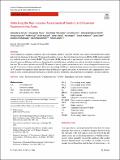Unlocking the Non-invasive Assessment of Conduit and Reservoir Function in the Aorta
Author(s)
de Vecchi, Adelaide; Faraci, Alessandro; Fernandes, Joao F.; Marlevi, David; Bellsham-Revell, Hannah; Hussain, Tarique; Laji, Nidhin; Ruijsink, Bram; Wong, James; Razavi, Reza; Anderson, David; Salih, Caner; Pushparajah, Kuberan; Nordsletten, David; Lamata, Pablo; ... Show more Show less
Download12265_2022_Article_10221.pdf (1.186Mb)
Publisher with Creative Commons License
Publisher with Creative Commons License
Creative Commons Attribution
Terms of use
Metadata
Show full item recordAbstract
Abstract
Aortic surgeries in congenital conditions, such as hypoplastic left heart syndrome (HLHS), aim to restore and maintain the conduit and reservoir functions of the aorta. We proposed a method to assess these two functions based on 4D flow MRI, and we applied it to study the aorta in pre-Fontan HLHS. Ten pre-Fontan HLHS patients and six age-matched controls were studied to derive the advective pressure difference and viscous dissipation for conduit function, and pulse wave velocity and elastic modulus for reservoir function. The reconstructed neo-aorta in HLHS subjects achieved a good conduit function at a cost of an impaired reservoir function (69.7% increase of elastic modulus). The native descending HLHS aorta displayed enhanced reservoir (elastic modulus being 18.4% smaller) but impaired conduit function (three-fold increase in peak advection). A non-invasive and comprehensive assessment of aortic conduit and reservoir functions is feasible and has potentially clinical relevance in congenital vascular conditions.
Graphical abstract
Date issued
2022-02-23Department
Massachusetts Institute of Technology. Institute for Medical Engineering & SciencePublisher
Springer US
Citation
de Vecchi, Adelaide, Faraci, Alessandro, Fernandes, Joao F., Marlevi, David, Bellsham-Revell, Hannah et al. 2022. "Unlocking the Non-invasive Assessment of Conduit and Reservoir Function in the Aorta."
Version: Final published version